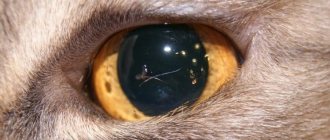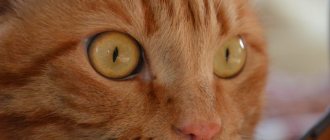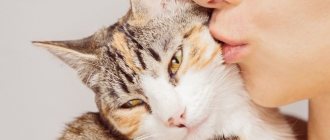Discharge from a cat's loop is a controversial phenomenon, since in some cases it can represent an absolutely normal condition, but in other situations it can be a serious signal of a problem with the pet's health. The most difficult thing in this matter is that it is quite difficult to distinguish abnormal discharge from normal discharge.
As a rule, discharge occurs normally in cats during pregnancy, the birth period, and also after it. Otherwise, if the cat is not pregnant, has not given birth or is breastfeeding, and has discharge, this is a reason to immediately consult a doctor, since the cause of such discharge can be serious illnesses, sometimes even leading to the death of the animal.
Types of discharge in cats
The most informative indicator is the color of the cat’s vaginal discharge. With its help, even the owner can make a presumptive diagnosis.
White
White discharge in a cat, accompanied by an unpleasant odor, is a consequence of an abscess, that is, suppuration. Most often it occurs against a background of weakened immunity after infection with protozoa and bacteria.
Pink or bloody
Bloody discharge in a cat varies in its abundance. Small droplets or whole clots may flow out of the loop. This symptom indicates damage to the blood vessels.
Purulent
Purulent discharge in a cat is always accompanied by an unpleasant odor. As the inflammatory process worsens, the clear liquid gradually thickens, acquiring a white tint. Over time, the pus becomes creamy, yellow, greenish, or brown. Darkening of the shade indicates necrotic processes in the mucous membranes.
Diagnostics
To conduct a quality diagnosis, the owner must contact a professional veterinarian. Why is diagnosis by a doctor important:
- He will make an accurate diagnosis based on the possible causes of the disease. The owner can hardly identify the causes for sure, or does not search for the causes at all and buys medications in accordance with the symptoms. But one symptom can indicate several diseases at once.
- Depending on the age, character, weight, breed, causes and stage of the disease, the veterinarian prescribes treatment. Complex diseases often require not just some medications, diets and observation, but step-by-step treatment in different ways. It is not uncommon for treatment to require surgery.
Brown discharge from a cat's eyes
Independent actions may turn out to be wrong and cause more harm to the animal.
Note! Observation by a specialist is the most reliable way to cure an animal without complications or death in the shortest possible time.
Diagnosis is carried out through examinations, tests, ultrasound and the use of special medical equipment to examine internal organs. Continuous specialist supervision may be required.
Diagnosis of a pet
Diagnostics reveals more causes and problems of the body at more serious stages, but this does not mean that when a disease occurs, you need to wait until the pet becomes very ill. The more serious the stage, the longer, more difficult and more expensive the treatment, and the chances of fully restoring health become less.
Non-dangerous causes of the problem
Non-dangerous reasons include physiological ones, that is, those associated with the characteristics of the body. Most often, mucous fluid appears during estrus, pregnancy and after childbirth.
Pregnancy and childbirth
By the 3rd week after mating, the cat begins to have a clear discharge with thick mucus. They are difficult to notice because they are excreted in the urine. The secreted mucus is excess plug that clogs the cervix. During pregnancy, it protects the fetus from infections.
Closer to 6 weeks, excess amniotic fluid comes out of the loop. It has a transparent or yellowish tint.
At 9 weeks the plug is rejected. Having noticed the appearance of a yellowish or greenish clot, you can begin preparing for childbirth. With the onset of contractions, the cat begins to have bloody discharge.
After the kittens are born, mucus may be released from the loop for another 3 weeks. No need to worry about this. Your cat's reddish discharge will gradually turn brown and disappear. Greenish inclusions are also acceptable these days.
Estrus
Unlike dogs, cats should not bleed during heat. The mucus emerging from the loop should be transparent and uniform in consistency. The presence of an unpleasant odor is unacceptable.
The duration of estrus is from 3 to 7 days. At this time, the pet becomes very excited and affectionate. She sleeps poorly at night, constantly meows and arches her back, moving her tail to the side when you press on her sacrum. The onset of estrus can only be noticed by behavioral changes, as the animal is constantly licking itself.
Prevention is the key to health
To keep your pet healthy, you need to follow preventive measures. A few basic rules:
- Careful observation of changes in the animal’s appearance and behavior;
- Regular visits to the veterinary clinic for a professional examination of the animal;
- If the cat has already had illnesses, you need to use prophylactic agents in the form of tablets or drops;
- Limit your stay on the street in areas where there are many homeless animals;
- Examine your pet yourself and eliminate foods that may cause disease.
The period of pregnancy and after childbirth requires special attention: during these periods the body is more vulnerable to the emergence of dangerous diseases that are primarily associated with the uterus. For example, after giving birth, you can call a veterinarian to your cat’s home for an examination; in no case should you allow the cat to be in hygienically unsuitable places in the first hours and days after birth: the street, the basement, contaminated places in the house. The same rules must be followed during childbirth.
If a cat has brown discharge from under its tail, it may be noticeable in the places where it sits. In some diseases, the discharge is very light and the animal will constantly lick it off. In this case, you need to pay attention to the fact that the cat will often begin to lick its perineum. In the second part of the disease or in severe stages, the mucus does not have time to be “cleaned up” by the cat itself and remains on the floor, furniture or rug. If your cat is leaking white fluid from under its tail, you should immediately consult a doctor.
Possible pathologies
Most pathological causes are associated with inflammation and infection of the uterus. This can lead to infertility and even death. To avoid complications, it is necessary to diagnose the existing disease as soon as possible and begin its treatment.
Pyometra
The risk group includes unsterilized animals over 5 years old. Due to hormonal imbalance, pus accumulates in the uterus, so the cat develops copious brownish or cream-colored discharge. Spots of the corresponding color can be seen on the bedding and other resting places of the pet.
The most dangerous form of pyometra is closed. With this disease, the pus does not extend beyond the uterus. This is accompanied by acute pain and enlargement of the abdomen. Over time, the walls of the organ cannot withstand and become damaged. The contents spill into the abdominal cavity, causing the death of the animal.
Endometritis
If a cat's white discharge appeared shortly after birth, then placenta particles could remain in the uterus. Their rotting can provoke endometritis - inflammation of the uterine mucosa. In addition to delayed placenta, the disease can occur due to hormonal imbalance and infection of the genital organs.
The appearance of abundant mucopurulent exudate is accompanied by frequent urination, loss of milk and severe pain. An advanced form of endometritis is fraught with the development of pyometra, infertility and sepsis.
Hematometer
Scanty bleeding in a cat, accompanied by fever and cramping pain, is characteristic of hematometra. With this pathology, blood accumulates in the uterus, since it cannot pass through the endocervix (mucous membrane of the cervix). Narrowing or blockage of the cervical canal occurs due to:
- muscle spasm;
- abortion or miscarriage;
- uterine fibroids;
- congenital anomalies;
- incorrectly performed operations;
- frequent childbirth.
Accumulating blood attracts pathogenic microorganisms. Over time, this leads to purulent inflammation - pyometra.
Hydrometer
With a hydrometer, secretions produced by the uterine glands, transudate and exudate, accumulate in the uterus. If the cervical canal is open or only partially blocked, a small amount of white or clear fluid will leak from the loop. This pathology is most easily detected in a sterilized cat whose discharge is not typical.
Hydrometra is often a complication of the chronic form of endometritis. Over time, the walls of the uterus stretch and become thinner. Scarring and adhesions appear at the site of ruptures. Without timely assistance, death occurs.
Vaginitis
With vaginitis, the walls of the vagina become inflamed and covered with ulcers. The catarrhal-purulent form of the pathology is complicated by an abscess. A sick cat develops a viscous white discharge that resembles thick cream.
The main causes of the disease are a sharp decrease in immunity and postpartum vaginal trauma. Opportunistic bacteria (Escherichia coli, streptococci, staphylococci) living in the body are activated and cause infection.
Other diseases
In addition to the listed diseases, bleeding, copious mucus and pus can be a symptom of several other pathologies. These include:
- Malignant tumors
. Blood appears not only in mucus, but also in urine and feces. As the condition worsens, pus is released. Oncology often occurs due to hormonal imbalances caused by taking drugs to suppress desire.
- Bleeding disorder
. Hematological pathology is accompanied by the appearance of scarlet liquid or clots.
- Vaginal phlegmon
. Inflammation affects the subcutaneous fat of the vulva. Due to the gradual growth of the organ, abscesses appear. The pus coming out of the vulva has a mucous consistency.
- Uterine trauma
. The appearance of scarlet blood shortly after sterilization is a complication caused by careless surgical intervention. In this case, it is better to call a veterinarian at home, since transporting the animal can aggravate its condition.
- Placental abruption or decomposition
. When placental abruption occurs, brown clots appear from the loop. If the kittens die in the womb, the color changes to green. Decomposition adds a strong, unpleasant odor. Bleeding may also occur. If these symptoms occur, you must urgently contact a doctor to prevent the death of the animal.
To identify a possible cause, it is necessary to take into account all accompanying symptoms. If the pet is active, eats well and takes care of the kittens, then you don’t have to worry about her.
Discharges considered physiological norm
Discharge is not always a sign of illness.
Consider cases where an unpleasant-looking sight occurs due to natural causes.
- In heat
. The name speaks for itself. Signals the time for mating. Lasts 3-7 days. The female is in an excited state. Meows loudly and hysterically. Doesn't sleep well. The front part of the body bends down, the back, on the contrary, lifts up. The exudate is transparent and odorless. - Postpartum period
. Typically, a woman in labor recovers after lambing within 21 days. Possible red-brown tint. They have a metallic taste. The new mother is cheerful, shows natural instinct (feeds, licks, protects the kittens). - During pregnancy,
it is considered natural until the third week (a plug forms) and bloody the day before birth.
Associated symptoms
Be sure to contact your veterinarian if the condition of your mustachioed pet causes you concern. Dangerous symptoms accompanying these pathologies include:
- extreme thirst, poor appetite and weight loss;
- excessive licking or biting of the perineum, as well as rolling on the floor on the butt;
- breathing problems and rapid heartbeat;
- vomiting, diarrhea, or constipation;
- deterioration in the appearance of fur;
- increased frequency and reduction of urination, as well as plaintive meowing every time you go to the toilet;
- lethargy, apathy or aggression;
- temperature increase;
- excessive attraction of cats in the absence of heat;
- rounding of the abdomen not associated with pregnancy.
If you find at least one of the listed signs, get diagnosed. The sooner treatment is started, the greater the chances of a quick recovery without complications.
Symptom during pregnancy and after childbirth
Excessive bleeding in cats during pregnancy, which is bright red or light in color and lasts more than 10 minutes, indicates damage to the uterus. In this case, you need to contact a specialist as soon as possible. Also, the appearance of brown liquid at 8-9 weeks of gestation should not be ignored.
The animal should be shown to a doctor. Laboratory tests are performed at the clinic. The veterinarian performs an ultrasound examination for the presence of dead fetuses and makes a decision about therapy.
Such a phenomenon does not always mean the presence of pathology. For example, after fertilization, you may notice pink fluid flowing from the animal's genital tract. Before the birth process begins, the discharge of dark blood is also considered quite normal. This symptom cannot be ignored when the kittens have already been born.
In this situation, it may indicate mechanical damage to the uterine tissue. Injuries often occur during the delivery process. To eliminate this problem, drugs that stop bleeding are used. In severe cases, surgical intervention is necessary. Sometimes a female who has recently given birth becomes infected in her genitals as a result of violation of sanitation rules. In this case, the cat experiences bleeding and pus. To prevent infection, it is important to keep the area where the mother and her babies are kept clean.
What should the owner do?
If physiological reasons are not suitable, and the pet’s condition does not return to normal, trust the veterinarian. Self-medication in such a situation can only aggravate the existing problem.
Diagnostics
The symptoms of many diseases are the same, so before starting treatment it is necessary to establish the exact cause of the ailment. In addition to examination and history taking, the following results will be required to make a diagnosis:
- general and biochemical blood test;
- Ultrasound of the abdominal cavity;
- vaginoscopy;
- x-ray;
- a smear or scraping from the vagina;
- bacterial sowing;
- biopsies.
The number of studies will depend on the condition of the animal. The list presented may be expanded or shortened.
Treatment
Depending on the diagnosis, drug or surgical treatment is used. Mild forms of infection, vaginitis and pyometra are treated with antibiotics and douching.
A more radical method of therapy is castration, that is, the complete removal of all reproductive organs. The operation is mandatory if there is a threat to life (malignant tumor, closed pyometra). Also, surgical intervention is necessary to correct the consequences of poor-quality sterilization and removal of placenta fragments.
How to help your pet
Loving owners always strive to help their pet. Whatever the methods, they must first of all be safe. If a cat is in heat, you need to encourage her natural urges and find a cat to breed. If you really don’t want your pet to have offspring, then you can “bring her back to her senses” with the help of special medications. For example, a special ointment that is applied to the nose every day. The animal will quickly return to its usual behavior and stop meowing loudly and chasing its owners.
Reference! If the discharge is not associated with estrus, then the best thing the owner can do is take the cat to the veterinarian, or call him at home (but if the disease is serious, then transportation to the clinic will be required).
The above diseases, after reading, should lead to the conclusion that the discharge indicates serious and dangerous diseases. Therefore, it is almost impossible to help your pet at home. Loss of appetite, baldness, deterioration in general condition and other dangerous symptoms cannot be “removed” on your own.
White discharge due to pyometra
One of the reasons for the production of white pus in a cat may be pyometra. This disease requires a very serious approach and intervention from specialists. The causes of this disease can be both hormonal imbalances in the pet and the consequences of endometritis.
If your cat's discharge is not properly treated, pyometra can appear very quickly.
The symptoms of this disease do not appear immediately. It's not just vaginal discharge. Signs such as fever, loss of appetite, thirst, and strange odors may appear. Closed pyometra is considered the most dangerous. In this case, the uterus is closed and prevents the cat from escaping white pus. Thus, the animal’s condition deteriorates very rapidly, leading to the fact that the pet can barely move.
Sometimes pyometra appears too late. There is no white watery discharge, and pus accumulates inside. Such processes can be fatal
. The discharge of pus in a cat is not always noticeable, so you should carefully monitor your pet's condition. This is important, because only the owner can notice in time and prevent terrible consequences.
Anal discharge: what to do?
If people notice oily discharge from the anus, they rarely consult a doctor. The feeling of awkwardness they experience prevents them from doing this. If fluid leaks from the anus, this should alert the person. Discharge from the anus may contain mucus, pus, blood clots, and oily contents. They are usually discovered during rectal emptying.
A person needs to understand that doctors constantly, in the course of their profession, encounter similar problems of their patients. Therefore, the patient’s modesty is inappropriate here. This is irresponsible towards your health. After all, the lack of adequate treatment, if necessary, can lead to serious complications.
Mucus from the anus
A pathological environment and mucus are formed. Sometimes it is mixed with purulent inflammatory exudate. This content has an unpleasant odor. Flatulence, diarrhea or constipation, and unproductive urge to defecate are observed. The patient suffers from a feeling of constant discomfort.
Oily discharge from the rectum
This symptom occurs when there are errors in diet and treatment: when eating certain types of fatty fish, tomatoes in large quantities, oral contraceptives, dietary supplements, medications, diet pills.
Oily discharge from the anus is accompanied by pathological stool, which is difficult to flush from the toilet and has an unusual shine.
Inflammation of the gallbladder and biliary tract, which is accompanied by dull aching pain in the right hypochondrium, diarrhea, abdominal pain, and pasty stools.
If the patient discovers such discharge from the anus, you need to adhere to a rational, low-fat diet, and after consulting with a doctor, stop taking the biodobe
Source
In the modern world, quite often people are faced with such a problem as discharge from the anus. This symptom always causes discomfort and is alarming. Quite often a late visit to the doctor occurs due to a feeling of awkwardness. The symptom can manifest itself in different ways: discharge is noted as an independent phenomenon, occurs during bowel movements, or can be in the form of an admixture in the stool. They can be mucous, purulent, bloody or mixed. But such a symptom can indicate a number of serious diseases, so it is recommended not to delay a visit to the proctologist.
Possible causes of anal discharge
Discharge in the form of mucus and pus is more common than discharge of blood from the anus. Most often, discharge is detected during the process of defecation, although it can also be released regardless of the process of emptying. The reasons that influence the appearance of discharge from the anus can be quite varied. Among them are:
As a result, due to the large amount of moisture, the skin wrinkles, and deep and painful cracks can form in the anus. When mucus gets on the cracks, it causes irritation and the patient experiences a feeling of burning, itching, and tingling.
Discharge from the anus may be mixed with pus or blood, accompanied by a false urge to defecate, and have an unpleasant odor. Discharge in the form of mucus most often indicates that the patient has a disease such as internal hemorrhoids, ulcerative colitis or fistula. When mucus is present in the stool, it is a sign of irritable bowel syndrome. The discharge may also be accompanied by diarrhea or constipation, bloating and a constant feeling of discomfort.
Diagnosis and treatment of anal discharge
If the first discharge from the anus is detected, you must immediately contact a face-to-face clinic.
Source
Care, maintenance and treatment of your pet
In order for treatment measures to bring positive results more quickly, owners need to provide the cat with proper care:
- Provide a secluded place for the animal, put a disposable sheet on the bed and change it regularly when it gets dirty.
- The room where the sick cat is located must be warm and free of drafts, and it must be ventilated regularly.
- During treatment, it is forbidden to let your pet go outside; its communication with other pets should be limited.
- The cat must have constant access to drinking water. If the animal refuses to drink or is too weak, you need to give it water yourself using a syringe, after removing the needle.
- During the illness, the animal should receive nutritious and easily digestible food. These can be meat broths, to which chopped meat, fermented milk products, cereals and vegetables are added in small quantities. On the advice of a veterinarian, you can purchase special medicated food so that the animal gains strength faster.
To protect your pet from diseases that lead to bleeding, you must adhere to the following preventive measures:
- If the cat is not intended for breeding, it makes sense to sterilize the pet. This will protect her from many diseases that occur in the genitourinary system. After the procedure, the cat should be regularly shown to the veterinarian for an ultrasound, this will help to better monitor the animal’s health.
- Get all necessary vaccinations and antihelminthic treatment in a timely manner to maintain the body's defenses.
- For mating, choose a healthy male cat; the owners of the male must document this.
- When giving birth to a cat, use sterile consumables and thoroughly treat your hands with antiseptics.
- If any unusual discharge occurs, you should take your cat to the veterinarian as soon as possible.
The measures described above will help not only prevent the development of the disease, but also, if necessary, show the cat to a specialist as soon as possible without wasting time.
Bloody discharge accompanied by a significant deterioration in the animal’s condition is a formidable sign indicating the development of severe pathology. There is no need to try to find the cause on your own, but take the cat to the veterinary clinic as soon as possible for examination and treatment.
Most owners periodically encounter certain problems with cats. For example, estrus is often accompanied by clear secretion, which is completely normal. However, what should you do if your cat has white discharge? What is their danger and how should such symptoms be dealt with? More on this later in the article.
How can you tell if an animal is unhealthy?
The phenomenon discussed in the article does not always indicate the presence of pathology. However, the presence of the disease may be indicated by the following accompanying symptoms:
- Reducing the pet's activity.
- Cat's refusal to eat.
- Frequent, infrequent or difficult urine output.
- Licking the perineal area.
- Heat.
- Increased heart rate, breathing problems.
If such signs occur, you urgently need to show the animal to a specialist who will carry out the necessary diagnostics. Examination using ultrasound and x-rays, laboratory tests of biological material will help determine what is causing the appearance of bloody discharge. If you consult a doctor in a timely manner, your pet can usually be cured.
In cats, spotting can be either normal or a sign of serious illness. In the first case, they accompany normal physiological processes, such as estrus or cleansing of the uterine cavity after childbirth. But if the discharge appears at the wrong time, causes discomfort to your pet and has a foul odor, you should consult a veterinarian as soon as possible. If this is not done, the animal may die.
So, how to distinguish normal discharge from pathological ones and how to treat a cat?
Presence of stones in the urinary system
This pathology is often found among domestic animals.
Most often it affects males. However, sometimes stones in the organs of the urinary system are found in females. The exact reasons for the formation of stones have not yet been identified. However, experts say that abuse of dry food, deficiency of vitamin A and fluid in the diet, excess weight, gastrointestinal diseases and poor heredity can provoke the disease. Stones are one possible explanation for why your cat is bleeding.
Dangerous diseases
Cats may experience atypical bloody discharge, which is a symptom of the following diseases:
- endometritis and pyometra are infectious diseases in which the uterine mucosa becomes inflamed and begins to bleed;
- inflammatory processes in the genital organs - their causes are varied, ranging from stress to infection, often ending in cystitis;
- phlegmon - under the influence of unfavorable factors, the cat experiences swelling of the genitals and the formation of ulcers;
- vaginitis - inflammation of the vagina caused by infections or injuries after unsuccessful medical procedures;
- tumor process in the uterus - as a rule, it is malignant in nature, the animal experiences destruction of soft tissues;
- placenta in the uterus - if not all placenta came out during childbirth, this leads to an inflammatory process in the uterus;
- various injuries to the genital organs - most often the cause is a poorly performed operation, which leads to bleeding.
The diseases described above have many similar symptoms:
- the animal becomes lethargic and drowsy;
- the cat tries to hide from its owners and other pets and shows no interest in playing;
- food refusal is observed, the animal may not drink well;
- a secretion is released from the genital organs, which, depending on the pathology, can be foul-smelling, with traces of pus and particles of mucous membrane;
- blood loss continues for a long time without a tendency to stop;
- The animal's temperature rises and does not subside.
To find out what exactly your pet is sick with, you need to contact a veterinarian as soon as possible. Independent attempts to find out what exactly is happening with the cat will not only not lead to success, but will also lead to the loss of precious time.










